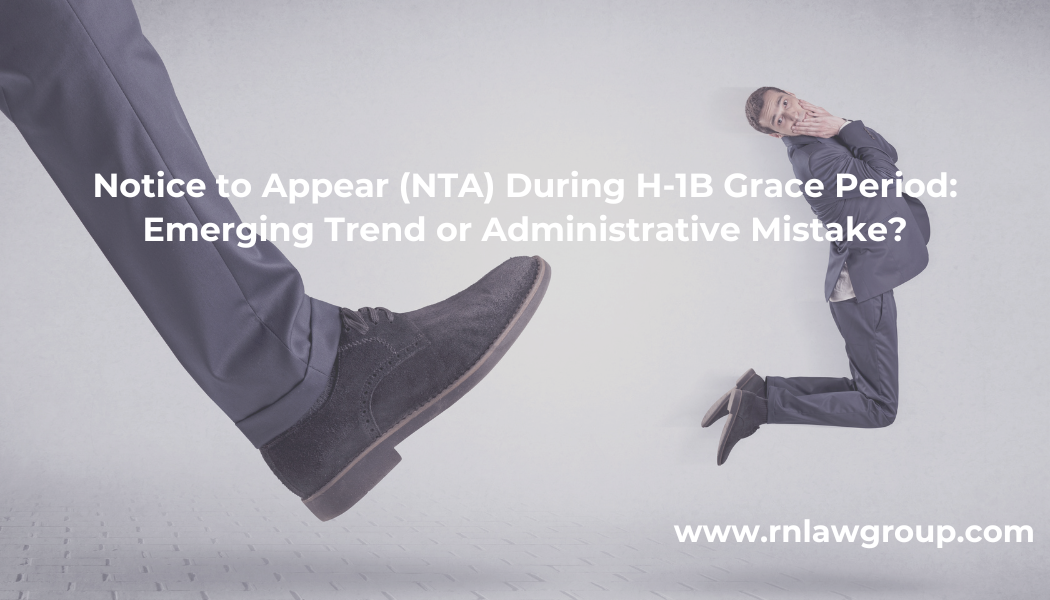
Notice to Appear (NTA) During H-1B Grace Period: Emerging Trend or Administrative Mistake?
An H-1B visa allows skilled professionals to work legally in the U.S. If these workers lose their jobs, U.S. immigration rules provide a 60-day grace period to find new employment or change status without violating immigration laws (1). However, recent reports indicate that Notices to Appear (NTAs)—documents initiating removal proceedings—are being issued to H-1B workers within this 60-day window. This raises serious questions: Is this a new enforcement trend or merely administrative errors?
Traditionally, the 60-day grace period is a safety net, giving H-1B employees time to secure new employment. During this period, workers are considered legally present and can remain in the U.S. if a new employer timely files an H-1B transfer petition (1). This policy ensures skilled professionals aren’t immediately penalized for job loss, reflecting a balanced approach to immigration enforcement.
However, recent policy shifts under the Trump administration, and continued enforcement today, have created confusion. In June 2018, USCIS expanded its guidelines for issuing NTAs, allowing immigration officers to start removal proceedings more frequently when petitions were denied, even if individuals had maintained lawful status until that point (2). Despite adjustments in recent years, the aggressive issuance of NTAs seems to have resurfaced, affecting professionals who follow proper procedures after losing a job.
Issuing NTAs during the lawful 60-day grace period contradicts USCIS’s own established guidelines and creates undue hardship. Workers receiving an NTA must appear before an immigration judge, a daunting experience that complicates future immigration matters. Moreover, it creates fear among skilled professionals who significantly contribute to the U.S. economy.
To avoid triggering an NTA, H-1B workers should take immediate action upon losing employment:
- Quickly secure new employment and have a new employer file an H-1B petition within the grace period.
- Consider filing a change-of-status application to another lawful category (like B-2 visitor status) if employment options aren’t immediately clear.
- Depart the U.S. voluntarily within the 60-day period if no viable options arise.
Workers receiving an NTA erroneously during the grace period should promptly seek legal counsel to contest the issue, as an immigration judge may dismiss improperly issued NTAs.
The current approach, driven by overly aggressive enforcement, undermines the intent of the grace period, harming both foreign professionals and American employers relying on skilled talent. USCIS should immediately clarify and rectify its policies to ensure fair treatment of H-1B workers, honoring the protections the law clearly provides.
References:
(1) USCIS Policy on 60-Day Grace Period for Nonimmigrant Workers: https://www.uscis.gov/working-in-the-united-states/information-for-employers-and-employees/options-for-nonimmigrant-workers-following-termination-of-employment
(2) USCIS Notice to Appear (NTA) Policy Memo (June 28, 2018): https://www.uscis.gov/legal-resources/notice-to-appear-policy-memorandum
By: Rahul Reddy
Rahul Reddy is the founding partner of Reddy Neumann Brown PC. He founded our firm in 1997 and has over 28 years of experience practicing employment-based immigration. Rahul‘s vast knowledge of the complex immigration system makes him an invaluable resource and an expert in the field. His personal experience with the immigration system has made him empathetic to each of his clients’ cases and empowered him to help others achieve the American Dream.
Rahul‘s dedication to serving the immigrant community is evident, from his daily free conference calls to his weekly immigration Q&As on Facebook and YouTube Live. He is an active member of the immigrant community and one of the founders of ITServe Alliance. He has been a member of American Immigration Lawyers Association since 1995.

